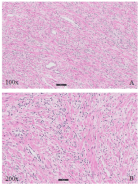Abstract
Research Article
Evaluation of Performance Research Nuclear Reactors' Steady-state and Kinetic Model Analyses
Esraa Fareed Saeed*
Published: 18 June, 2024 | Volume 8 - Issue 1 | Pages: 039-044
The mainstays of nuclear substance radiation and isotopic synthesis are nuclear-powered power plants, however effective safety evaluation is made tougher by the complicated construction topologies and physical connection effects. This work proposes a multiphysics-linked technique for evaluating both the kinetic and steady-state behaviors of the MPRR and LVR-15 laboratory reactors. To represent complicated member geometries, homogenized assembling sections are generated using two-dimensional whole-core computational simulations. It is discovered that the steady-state findings and the so-called Monte Carl solution comparisons correspond quite nicely. The greatest assemble power mistakes for LVR-15 and MPRR are 6.49%/10%, and the highest command rod value mistakes are 31 pcm/136 pcm, and the mistakes are 377 pcm/383 pcm, accordingly. Meanwhile, the study is done on transitory procedures, such as reactivity-initiated disasters and exposed loss-of-flow mishaps. Both units' modeling findings show plausible adverse feedback events. Furthermore, it is shown that the two reactors' accident-related behaviors are comparable though having different core architectures since they employ the exact same kinds of water as a fluid. The technique for studying nuclear power plant kinetics known as Multi-Physics Simulation (MPM) is explained. Drawing on many research and verification efforts conducted at Politecnico di Milan, Italy, MPM is shown to be a valuable instrument for managing reactors' security and oversight. It may be viewed as a holistic analytical tool that is implemented during the reactor architecture design phase. The capacity to concurrently answer the interrelated equations that control the many physical processes taking place in a nuclear plant inside the same simulated setting is a core characteristic of MPM.
Read Full Article HTML DOI: 10.29328/journal.acee.1001064 Cite this Article Read Full Article PDF
Keywords:
MPM; Equations; Nuclear power; Plant kinetics
References
- Nguyen N, Nguyen K, Huynh T, Vo D, Tran H. Conceptual design of a 10 MW multipurpose research reactor using VVR-KN fuel. Sci Technol Nucl Install. 2020;2020:1-10.
- Almachi JC, Sánchez-Espinoza VH, Imke U. High-Fidelity Steady-State and Transient Simulations of an MTR Research Reactor Using Serpent2/Subchanflow. Energies. 2022; 15(4):1554.
- Ferraro D, García M, Valtavirta V, Imke U, Tuominen R, Leppänen J, et al. Serpent/SUBCHANFLOW pin-by-pin coupled transient calculations for the SPERT-IIIE hot full power tests. Ann Nucl Energy. 2020; 142:107387.
- Zhang T, Li Z. Variational nodal methods for neutron transport: 40 years in review. Nucl Eng Technol. 2022;59(9):3181-3204.
- Khan DA, Khan N, Ilyas N, Gul MT. Mechanisms of Stress Tolerance in Halophytic Plants. The Metascience. 2024;2(2):9-16.
- Ibrar M, Rahim K, Ullah S, Gul MT. A Brief Overview On The Highly Medicinal Plant Genus Gomphrena. The Metascience. 2024;2(1):84-91.
- Khan N, Ilyas N, Gul MT. Mycorrhizal Associations' Significance for Plant Nutrition. The Metascience. 2024;2(2):1-8.
- Ullah I, Khan N, Gul MT. Plants' Physiological Reactions to Climate Change. The Metascience. 2024;2(1):76-83.
- Xiao W, Sun Q, Liu X, He H, He D, Pan Q, Zhang T. Application of stiffness confinement method within variational nodal method for solving time-dependent neutron transport equation. Comput Phys Commun. 2022;108450.
- Sun Q, Zhang T, Liu X, Chai X, Xiong J. A Discrete-Ordinates Variational Nodal Method for Solving Multidimensional Neutron Transport Equation with Unstructured Mesh. In: International Conference on Nuclear Engineering. American Society of Mechanical Engineers; 2022. pp. ICONE29–91525.
- Zhang T, Xiao W, Yin H, Sun Q, Liu X. VITAS: A multi-purpose simulation code for the solution of neutron transport problems based on variational nodal methods. Ann Nucl Energy. 2022;178:109335.
- Tang J, Huang M, Zhao Y, Maqsood S, Ouyang X. Numerical investigations on the melting process of the nuclear fuel rod in RIAs and LOCAs. Int J Heat Mass Transfer. 2018;124:990-1002.
- Wang J, Wang Q, Ding M. Review on neutronic/thermal-hydraulic coupling simulation methods for nuclear reactor analysis. Ann Nucl Energy. 2020;137:107165.
- Dambrosio A, Ruˇsˇc´ak M, Mazzini G, Musa A. Neutronic analysis of the LVR-15 research reactor using the PARCS code. Ann Nucl Energy. 2018;117:145-154.
- Phan G, Tran HN, Nguyen KC, Tran VP, Hoang VK, Ha PNV, et al. Comparative analysis of the Dalat nuclear research reactor with HEU fuel using SRAC and MCNP5. Sci Technol Nucl Install. 2017;2017:.
- Arinkin FM, Shaimerdenov AA, Gizatulin S, Dyusambaev DS, Koltochnik SN, Chakrov PV, et al. Core conversion of VVR-K research reactors. At Energy. 2017;123(1):17-24.
- Evans JA, DeHart MD, Weaver KD, Keiser DD. Burnable absorbers in nuclear reactors – a review. Nucl Eng Des. 2022;391:111726.
- Feng K, Wu Y, Hu J, Jin X, Gu H. Preliminary analysis of a zirconium hydride moderated megawatt heat pipe reactor. Nucl Eng Des. 2022;388:111622.
- Guo H, Buiron L, Sciora P, Kooyman T. Optimization of reactivity control in a small modular sodium-cooled fast reactor. Nucl Eng Technol. 2020;52:1367-1379.
- Guo H, Feng KY, Gu HY, Yao X, Bo L. Neutronic modeling of megawatt-class heat pipe reactors. Ann Nucl Energy. 2021;154:108140.
- Im J, Jeong MJ, Choi N, Kim KM, Cho HK, Joo HG. Multiphysics analysis system for heat pipe cooled micro reactors employing PRAGMA-OpenFOAM-ANLHTP. Nucl Sci Eng. 2023;197:1743-1757. doi:10.1080/00295639.2022.2143209
- Li J, Cai J, Li X. Conceptual design and feasibility analysis of a megawatt level low enriched uranium heat pipe cooled reactor core. Ann Nucl Energy. 2023;181:109576. doi:10.1016/j.anucene.2022.109576
- Liu L, Liu B, Xiao Y, Gu H, Guo H. Preliminary thermal and mechanical analysis on the reactor core of a new heat pipe cooled reactor applied in the underwater environment. Prog Nucl Energy. 2022;150:104306. doi:10.1016/j.pnucene.2022.104306
- Liu X, Zhang R, Liang Y, Tang S, Wang C, Tian W, et al. Core thermal-hydraulic evaluation of a heat pipe cooled nuclear reactor. Ann Nucl Energy. 2020;142:107412. doi:10.1016/j.anucene.2020.107412
- Ma Y, Chen E, Yu H, Zhong R, Deng J, Chai X, et al. Heat pipe failure accident analysis in megawatt heat pipe cooled reactor. Ann Nucl Energy. 2020;149:107755. doi:10.1016/j.anucene.2020.107755
- Morris ED, Endres CJ, Schmidt KC, Christian BT, Muzic Jr. RF, Fisher RE. Kinetic modeling in positron emission tomography. 2004;539.
- Aufiero M, Cammi A, Fiorina C, Luzzi L, Sartori A. Development of advanced simulation tools for circulating-fuel nuclear reactors. 2014.
- Zhang T, Yang M, Luo C. Multi-physics coupled analyzes of research nuclear reactors based on steady-state and kinetics models. Ann Nucl Energy. 2022;196:110231.
- He H, Chai X, Liu X. Multi-physics coupled analyzes of research nuclear reactors based on steady-state and kinetics models. Ann Nucl Energy. 2022;196:110231.
- Baker DR, Sreenivasan S. Discrepancy between Monte-Carlo results and analytic values for the average excluded volume of rectangular prisms. 2002.
- Eugene H. Discrepancy between Monte-Carlo results and analytic values for the average excluded volume of rectangular prisms. 2002.
Figures:
Similar Articles
-
Wave Forces on Vertical Structures in Shallow Water: Numerical EvaluationFabio Dentale*,Ferdinando Reale,Angela Di Leo,Eugenio Pugliese Carratelli,Marina Monaco. Wave Forces on Vertical Structures in Shallow Water: Numerical Evaluation. . 2017 doi: 10.29328/journal.acee.1001003; 1: 020-033
-
A qualitative method for determining the surfaces between asphalt layers using ABAQUS softwareSeyed Masoud Hadian*. A qualitative method for determining the surfaces between asphalt layers using ABAQUS software. . 2019 doi: 10.29328/journal.acee.1001014; 3: 025-031
-
Evaluation of Performance Research Nuclear Reactors' Steady-state and Kinetic Model AnalysesEsraa Fareed Saeed*. Evaluation of Performance Research Nuclear Reactors' Steady-state and Kinetic Model Analyses. . 2024 doi: 10.29328/journal.acee.1001064; 8: 039-044
Recently Viewed
-
Non-surgical Treatment of Verrucous Hyperplasia on Amputation Stump: A Case Report and Literature ReviewSajeda Alnabelsi*, Reem Hasan, Hussein Abdallah, Suzan Qattini. Non-surgical Treatment of Verrucous Hyperplasia on Amputation Stump: A Case Report and Literature Review. Ann Dermatol Res. 2024: doi: 10.29328/journal.adr.1001034; 8: 015-017
-
Outpatient operative hysteroscopy: evaluation of patient satisfaction and acceptanceClare Margaret Crowley*,Noelle Gill,Minna Geisler. Outpatient operative hysteroscopy: evaluation of patient satisfaction and acceptance. Clin J Obstet Gynecol. 2022: doi: 10.29328/journal.cjog.1001098; 5: 005-008
-
Predictors of positive treatment response to PTNS in women with overactive bladderSuneetha Rachaneni*,Doyo Enki,Megan Welstand,Thomasin Heggie,Anupreet Dua. Predictors of positive treatment response to PTNS in women with overactive bladder. Clin J Obstet Gynecol. 2022: doi: 10.29328/journal.cjog.1001097; 5: 001-004
-
Prediction of neonatal and maternal index based on development and population indicators: a global ecological studySedigheh Abdollahpour,Hamid Heidarian Miri,Talat Khadivzadeh*. Prediction of neonatal and maternal index based on development and population indicators: a global ecological study. Clin J Obstet Gynecol. 2021: doi: 10.29328/journal.cjog.1001096; 4: 101-105
-
A Genetic study in assisted reproduction and the risk of congenital anomaliesKaparelioti Chrysoula,Koniari Eleni*,Efthymiou Vasiliki,Loutradis Dimitrios,Chrousos George,Fryssira Eleni. A Genetic study in assisted reproduction and the risk of congenital anomalies. Clin J Obstet Gynecol. 2021: doi: 10.29328/journal.cjog.1001095; 4: 096-100
Most Viewed
-
Evaluation of Biostimulants Based on Recovered Protein Hydrolysates from Animal By-products as Plant Growth EnhancersH Pérez-Aguilar*, M Lacruz-Asaro, F Arán-Ais. Evaluation of Biostimulants Based on Recovered Protein Hydrolysates from Animal By-products as Plant Growth Enhancers. J Plant Sci Phytopathol. 2023 doi: 10.29328/journal.jpsp.1001104; 7: 042-047
-
Sinonasal Myxoma Extending into the Orbit in a 4-Year Old: A Case PresentationJulian A Purrinos*, Ramzi Younis. Sinonasal Myxoma Extending into the Orbit in a 4-Year Old: A Case Presentation. Arch Case Rep. 2024 doi: 10.29328/journal.acr.1001099; 8: 075-077
-
Feasibility study of magnetic sensing for detecting single-neuron action potentialsDenis Tonini,Kai Wu,Renata Saha,Jian-Ping Wang*. Feasibility study of magnetic sensing for detecting single-neuron action potentials. Ann Biomed Sci Eng. 2022 doi: 10.29328/journal.abse.1001018; 6: 019-029
-
Pediatric Dysgerminoma: Unveiling a Rare Ovarian TumorFaten Limaiem*, Khalil Saffar, Ahmed Halouani. Pediatric Dysgerminoma: Unveiling a Rare Ovarian Tumor. Arch Case Rep. 2024 doi: 10.29328/journal.acr.1001087; 8: 010-013
-
Physical activity can change the physiological and psychological circumstances during COVID-19 pandemic: A narrative reviewKhashayar Maroufi*. Physical activity can change the physiological and psychological circumstances during COVID-19 pandemic: A narrative review. J Sports Med Ther. 2021 doi: 10.29328/journal.jsmt.1001051; 6: 001-007

HSPI: We're glad you're here. Please click "create a new Query" if you are a new visitor to our website and need further information from us.
If you are already a member of our network and need to keep track of any developments regarding a question you have already submitted, click "take me to my Query."

















































































































































